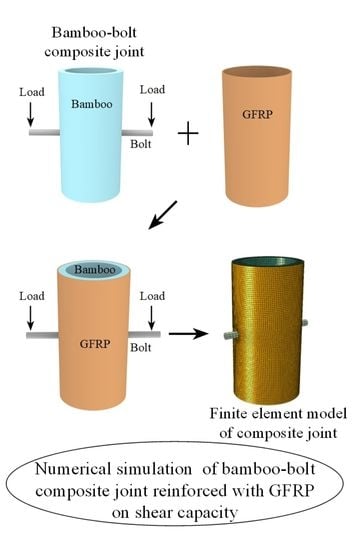Numerical Simulation of the Shear Capacity of a GFRP-Strengthened Natural Bamboo-Bolt Composite Joint
Abstract
:1. Introduction
2. Geometric Data of the Composite Joint Model and Shear Test Method
3. Numerical Analysis and Verification
3.1. Geometric Model and Material Properties
3.2. Meshing and Boundary Conditions
3.3. Simulated Loading and Test Verification
4. Results and Discussion
4.1. Comparison of the Simulation Results and Test Results
4.1.1. Stress Cloud Diagram and Failure Mode
4.1.2. Comparison between the Model and Specimen
- (1)
- Elastic linear growth stage:
- (2)
- Elastic–plastic slow growth stage:
4.2. Parameter Analysis of the Simulation Model
5. Analytical Approaches
- My—the yield moment of the bolt, in N·mm;
- fu—the tensile strength of the bolt, in N/mm2;
- d—the diameter of the bolt, in mm.
6. Conclusions
Author Contributions
Funding
Institutional Review Board Statement
Informed Consent Statement
Data Availability Statement
Acknowledgments
Conflicts of Interest
References
- Chen, X.; Xu, Q.F.; Harries, K.A. Research on Mechanical Properties and Application of Bamboo in Civil Engineering: State-of-the-art. Struct. Eng. 2015, 31, 208–217. [Google Scholar]
- Zhou, G.M.; Jiang, P.K. Density, Storage and Spatial Distribution of Carbon in Phyllostachy pubescens forest. Sci. Silvae Sin. 2004, 40, 5. [Google Scholar]
- Zhou, Y.F.; Gu, L.; Liu, H.Z.; Zhou, G.M.; Li, C.Q.; Shi, Y.J.; Han, X.; Lin, H. Carbon Transfer During Manufacturing of Moso Bamboo Plank Using the Bamboo Unfolding and Flattening Technology. Sci. Silvae Sin. 2013, 49, 96–102. [Google Scholar]
- Liu, J.; Zhang, J.L.; Guo, J.; Li, Y.S. The Development Status of the Modern Bamboo Structure Buildings. For. Eng. 2013, 29, 126–130. [Google Scholar]
- Zhou, Y.; Deng, Y.S.; Peng, K.; Wang, L. Application of Bamboo Pipe Piles in Civil Engineering. J. Hubei Univ. Technol. 2018, 33, 72–75. [Google Scholar]
- Zhou, J.W.; Zhao, F.H.; Qi, Y.S.; Zhu, J.Q.; Chen, Y.H. Experimental Research on Seismic Behavior of A New Fabricated Bamboo (Timber) Frame Connection. Ind. Constr. 2017, 47, 70–74. [Google Scholar]
- Zhang, H.Z.; Wang, L.J.; Yang, T.L.; Yang, Y.G.; Li, H.Y. Theoretical Research on Nodes of Bamboo Structures under Simple Shear. Build. Struct. 2017, 44, 20–21. [Google Scholar]
- Yan, Y.F.; Chen, Y.L.; Wen, Z.S.; Zhou, Q. The Exposition and Evaluation of the Modern Original Bamboo Structure Node Construction Logic. Archit. Technol. 2014, 5, 116–117. [Google Scholar]
- Morisco. Yogyakarta: Nafiri Offset. Rekayasa Bambu. 1999. [Google Scholar]
- Hu, H.; Yang, J.; Wang, F.L.; Zhang, Y.M. Mechanical Properties of Bolted Joints in Prefabricated Round Bamboo Structures. J. For. Eng. 2018, 3, 128–135. [Google Scholar]
- Feng, P.; Ye, L.P.; Meng, X.M. Progress in the Study of FRP Strengthened Metallic Structures. In Proceedings of the 22nd National Conference on Structural Engineering, Urumqi, China, 25 November 2013; p. 20. [Google Scholar]
- Lu, Y.Y.; Huang, Y.S.; Zhang, H.J.; Liu, L. New Progress in the Study of the Technology of Reinforcement with Fiber Reinforced Plastics. China Railw. Sci. 2006, 27, 34–42. [Google Scholar]
- Han, J.; Liu, W.Q.; Fang, H. Application of fiber-reinforced resin matrix composites in the civil infrastructure field. J. Nanjing Technol. Univ. (Nat. Sci. Ed.) 2020, 42, 543–554. [Google Scholar]
- Perfetto, D.; Greco, A.; Caputo, F. Experimental investigation of GFRP plates under LVI phenomena with different impact energy levels. In Proceedings of the AIP Conference Proceedings, Maharashtra, India, 5–6 July 2018; p. 20137. [Google Scholar]
- Davalos, J.F.; Zipfel, M.G.; Qiao, P. Feasibility study of prototype GFRP-reinforced wood railroad crosstie. J. Compos. Constr. 1999, 3, 92–99. [Google Scholar] [CrossRef]
- Nor, N.M.; Xin, T.H.; Yusof, M.A. Enhancing Strength of Bamboo using GFRP and PU. Int. J. Sustain. Constr. Eng. Technol. 2020, 11, 21–26. [Google Scholar]
- Zhang, Z.; Meng, X.; Zhai, J.; Feng, P. Experimental Study on Mechanical Properties of Bamboo Culms and Joints Reinforced with GFRP Sheets. In International Conference on Fibre-Reinforced Polymer (FRP) Composites in Civil Engineering; Springer: Cham, Switzerland, 2021; pp. 1601–1613. [Google Scholar]
- Awaludin, A.; Andriani, V. Bolted bamboo joints reinforced with fibers. Procedia Eng. 2014, 95, 15–21. [Google Scholar] [CrossRef] [Green Version]
- Fu, W.S.; Zhao, Z.R.; Han, W.; Zhou, J.B. Research on finite element model for parallel to bamboo culms axial shear. Appl. Mech. Mater. 2014, 477, 986–989. [Google Scholar] [CrossRef]
- Wei, Y.; Yan, S.C.; Chen, S.; Duan, M.J.; Wang, L.B. Numerical simulation on bending performance of FRP reinforced bamboo beams. Acta Mater. Compos. Sin. 2019, 36, 1036–1044. [Google Scholar]
- Li, J. Experimental Study on Mechanical Properties of Stirrup Enhanced Glued Bamboo Columns. Master’s Thesis, Chongqing Jiaotong University, Chongqing, China, 2014. [Google Scholar]
- Perfetto, D.; Lamanna, G.; Sepe, R.; Luca, A.D. Design of a Bamboo Treadmill Bicycle Main Frame. Macromol. Symp. 2020, 389, 1900101. [Google Scholar] [CrossRef]
- Chen, Z.H.; Luo, Q.W. Numerical simulation of mechanical properties of gfrp-concrete composite beam with consideration of interface bond-slip. Ind. Constr. 2019, 49, 64–69. [Google Scholar]
- Thorsson, S.I.; Waas, A.M.; Rassaian, M. Low-velocity impact predictions of composite laminates using a continuum shell based modeling approach part A: Impact study. Int. J. Solids Struct. 2018, 155, 185–200. [Google Scholar] [CrossRef]
- Schwarze, M.; Vladimirov, I.N.; Reese, S. A new continuum shell finite element for sheet metal forming applications. Int. J. Mater. Form. 2010, 3, 919–922. [Google Scholar] [CrossRef]
- Hu, H. Research on Bolt Joint’s Mechanical Properties of Prefabricated Bamboo Structure. Master’s Thesis, Shanghai Jiao Tong University, Shanghai, China, 2018. [Google Scholar]
- Ministry of Construction of the PRC. Testing Methods for Physical and Mechanical Properties of Bamboo Used in Building; China Architecture & Building Press: Beijing, China, 2007.
- Standardization Administration of China. Fiber-Reinforced Plastics Composites-Determination of Tensile Properties; Standardization Administration of China: Beijing, China, 2005. [Google Scholar]
- Standardization Administration of China. Test Method for Longitudinal Transverse Shear (L-T Shear) Properties of Fiber Reinforced Plastics; Standardization Administration of China: Beijing, China, 2005. [Google Scholar]
- Jiao, G.Q.; Jia, P.R. Mechanics of Composite Materials; Northwest University of Technology Press: Xi’an, China, 2008. [Google Scholar]
- Eid Alajmi, A.; Alotaibi, J.G.; Yousif, B.F.; Nirmal, U. Tribological studies of bamboo fibre reinforced epoxy composites using a BOD technique. Polymers 2021, 13, 2444. [Google Scholar] [CrossRef]
- Song, S.Z.; Wei, J.J.; Chen, C. A study on the performance of tubular T-Joints strengthend with CFRP subjected to monotonic loading. Prog. Steel Build. Struct. 2015, 2, 57–64. [Google Scholar]
- Luo, J.H. Experimental Study and Numerical Simulation of CFRP Reinforced Compression Square Steel Pipe. Master’s Thesis, Hefei University of Technology, Hefei, China, 2019. [Google Scholar]
- Johansen, K.W. International Association of Bridge and Structural Engineering. Theory Timber Connect. 1949, 9, 249–262. [Google Scholar]
- Oka, G.M.; Triwiyono, A.; Awaludin, A.; Siswosukarto, S. Experimental and theoretical investigation of bolted bamboo joints without void filled material. Appl. Mech. Mater. 2015, 776, 59–65. [Google Scholar] [CrossRef]
- BSI. Design of Timber Structures-Part 1-1: General-Common Rules and Rules for Buildings: BS EN 1995-1-1, Eurocode 5; British Standards Institution: London, UK, 2004. [Google Scholar]
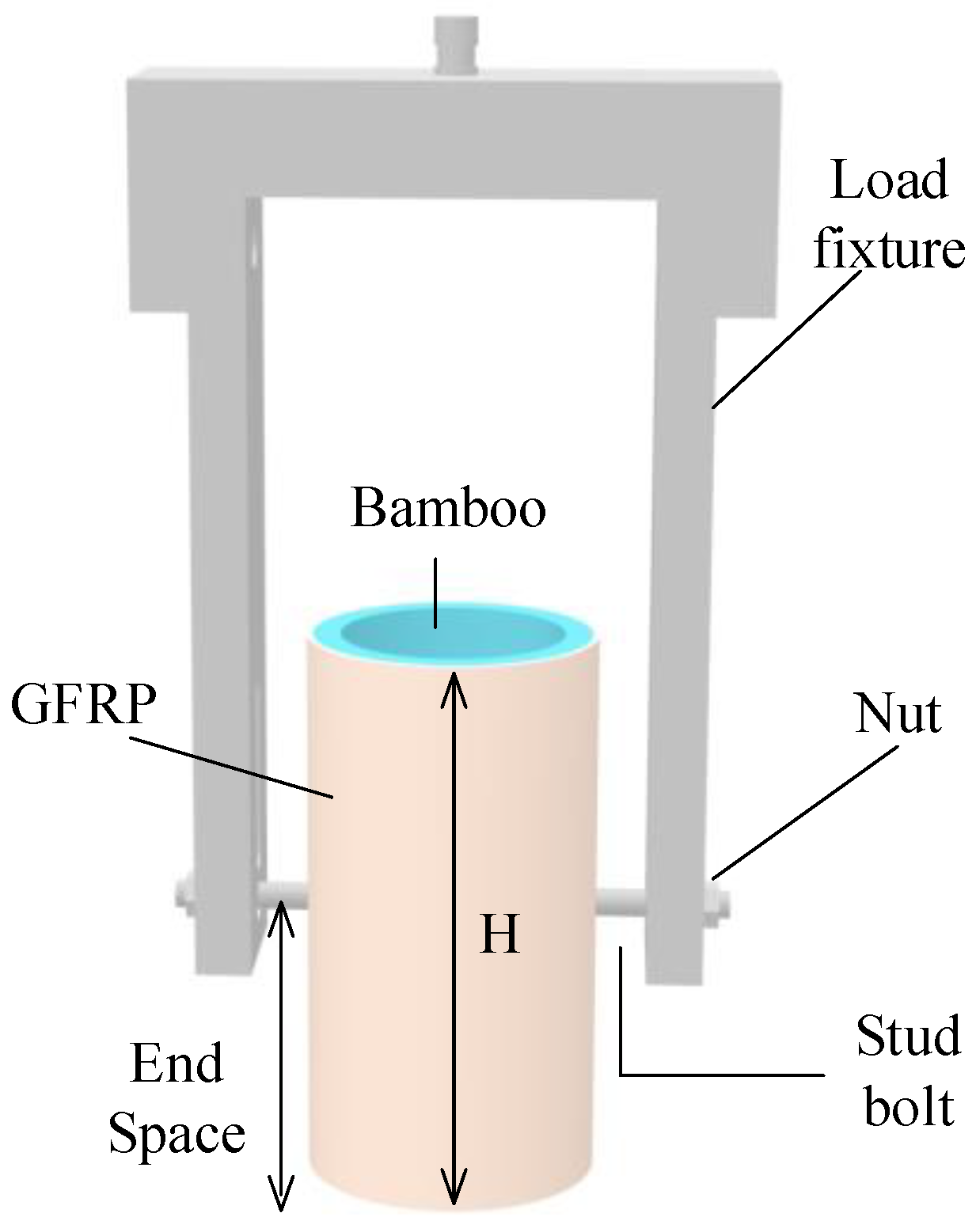
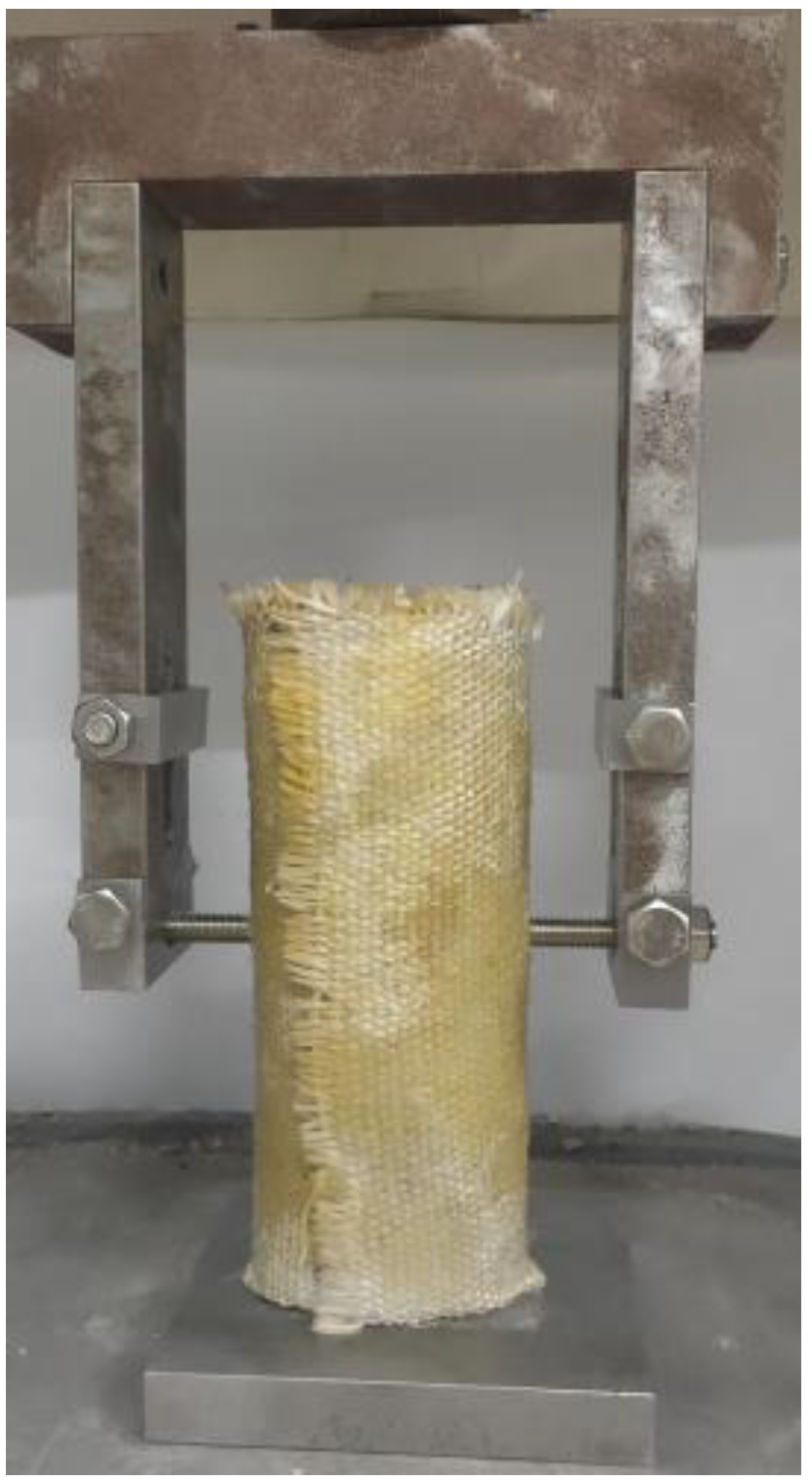
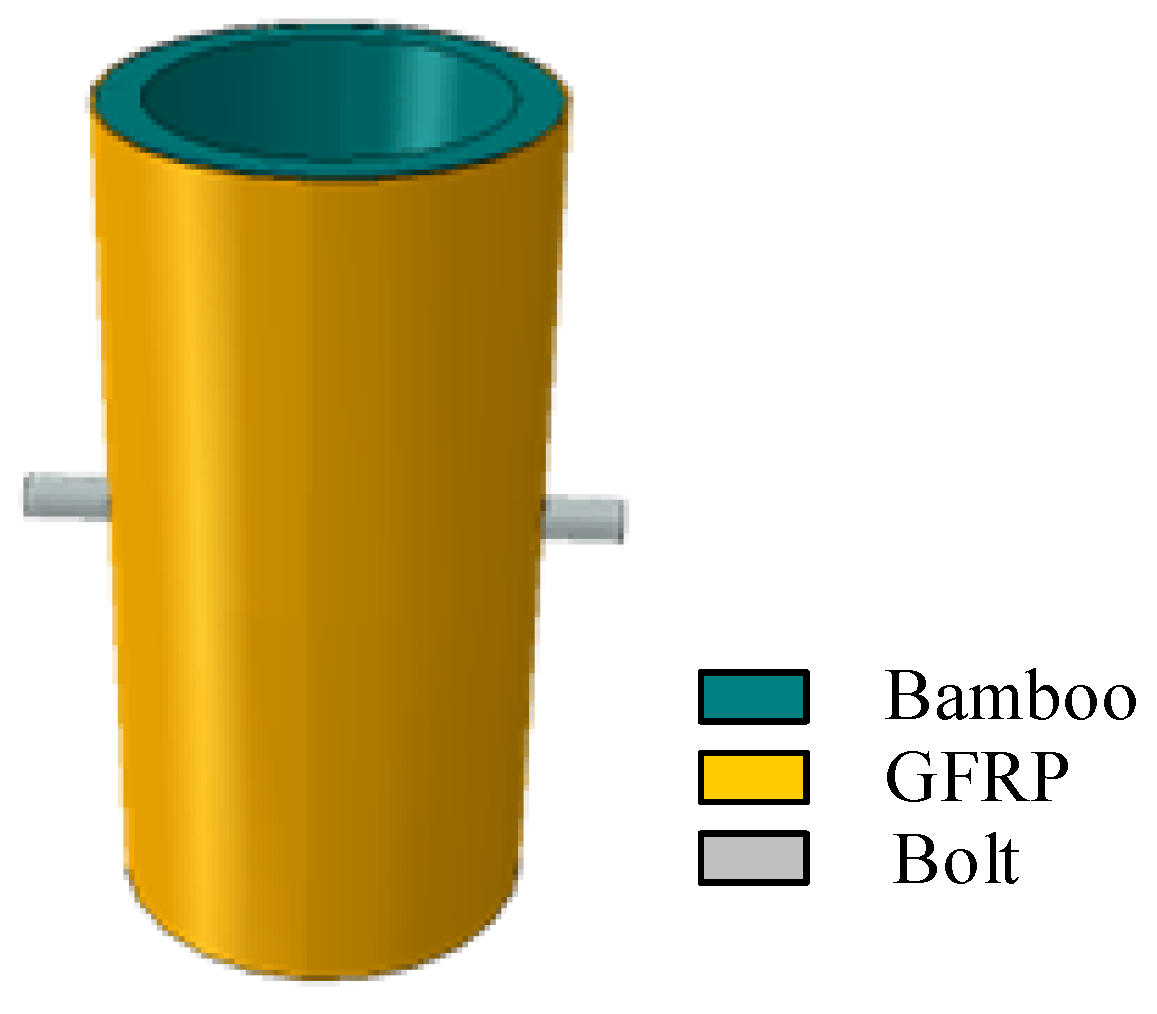
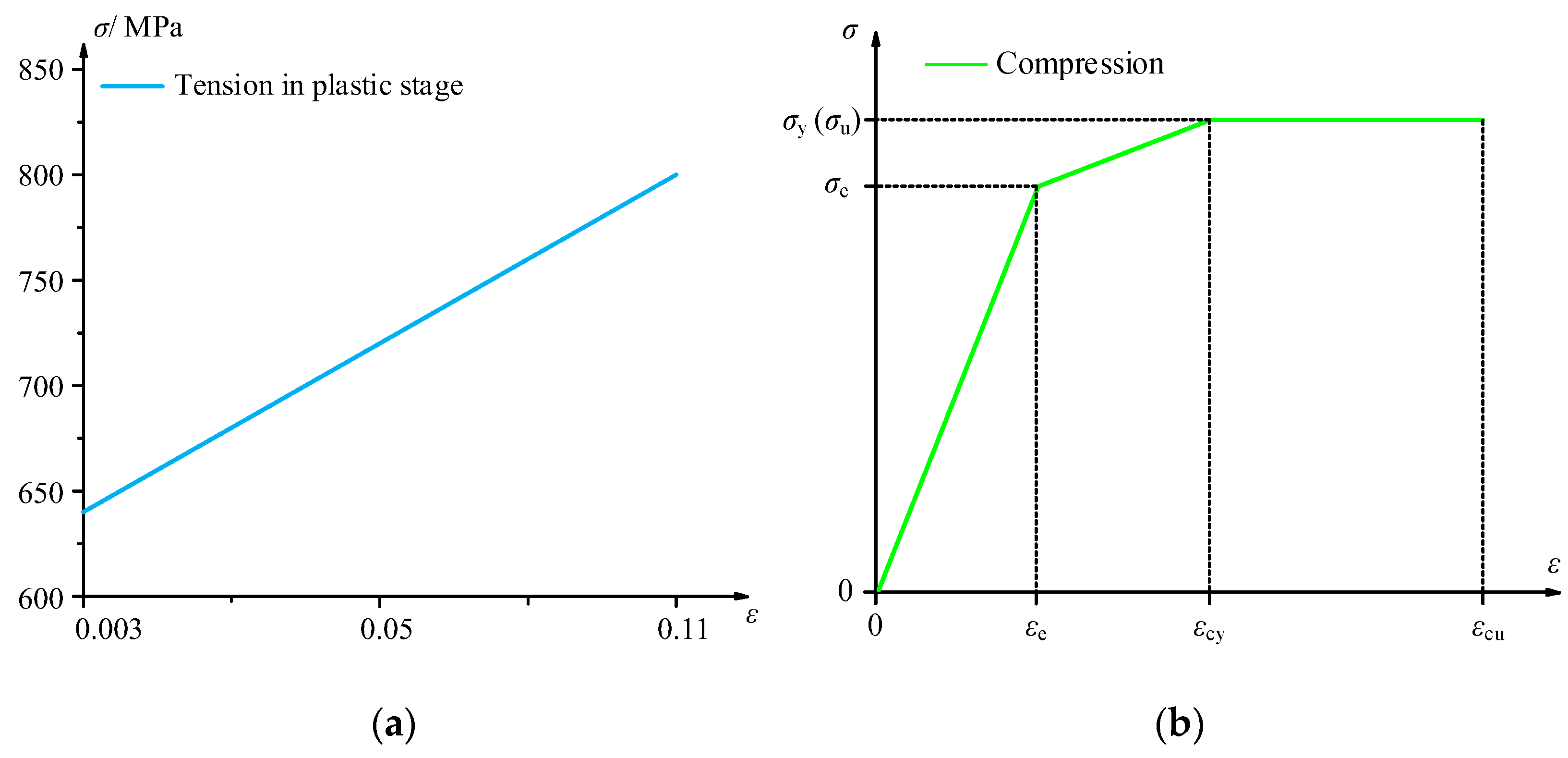
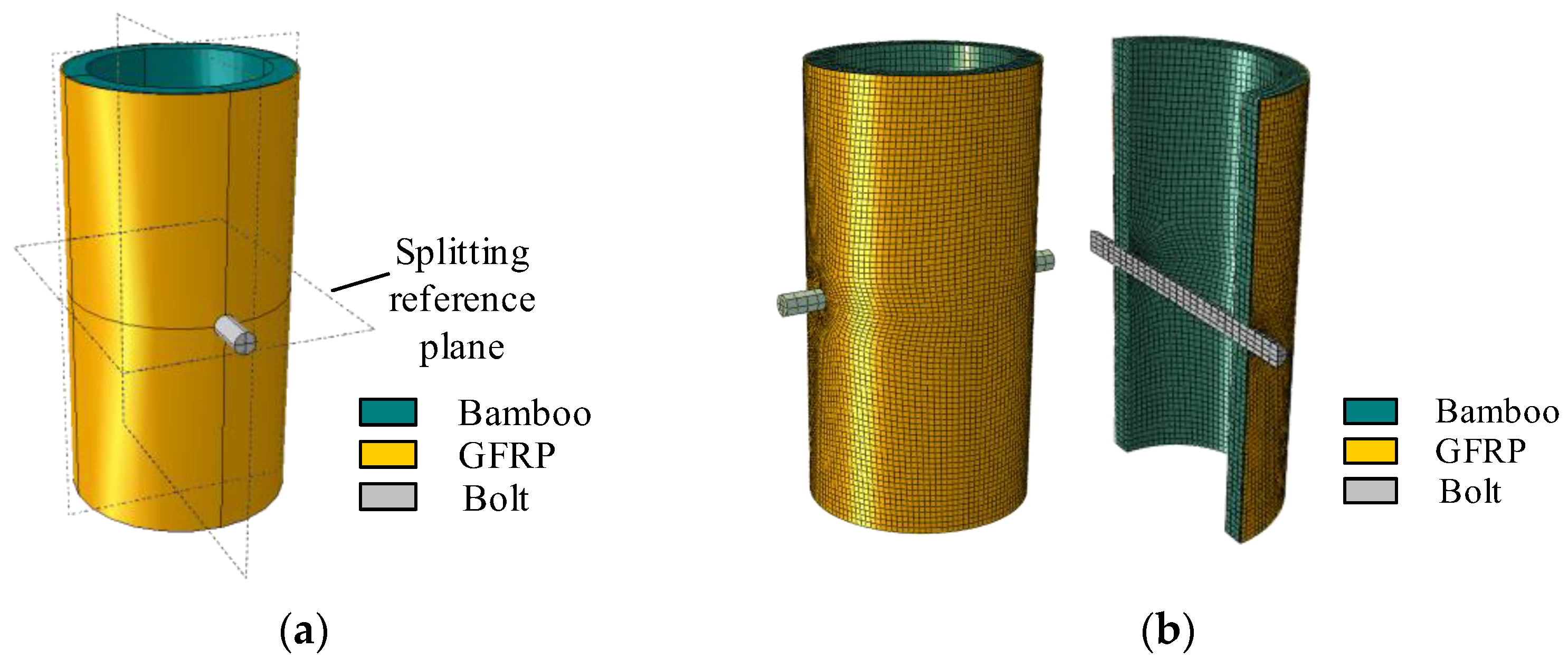


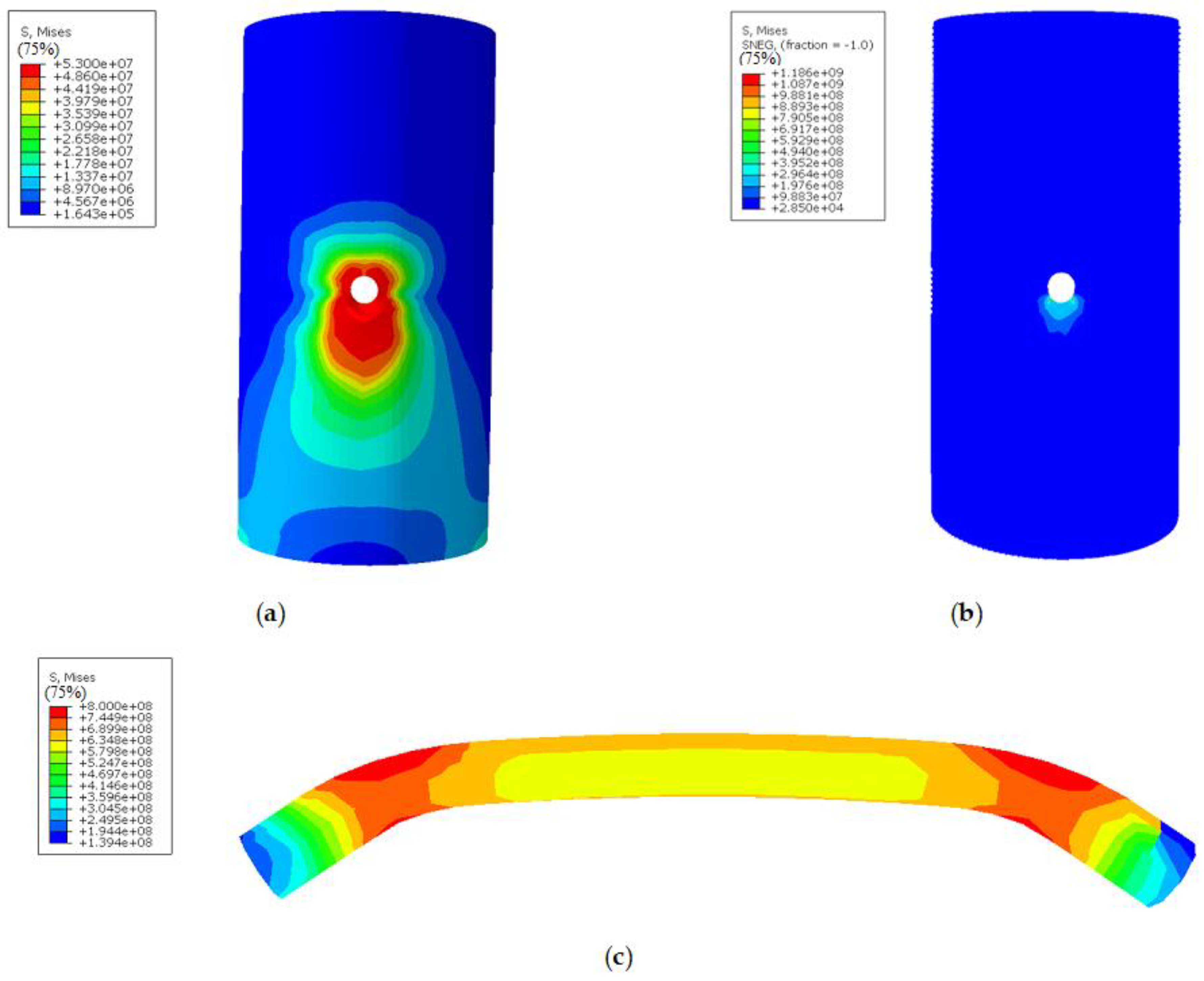
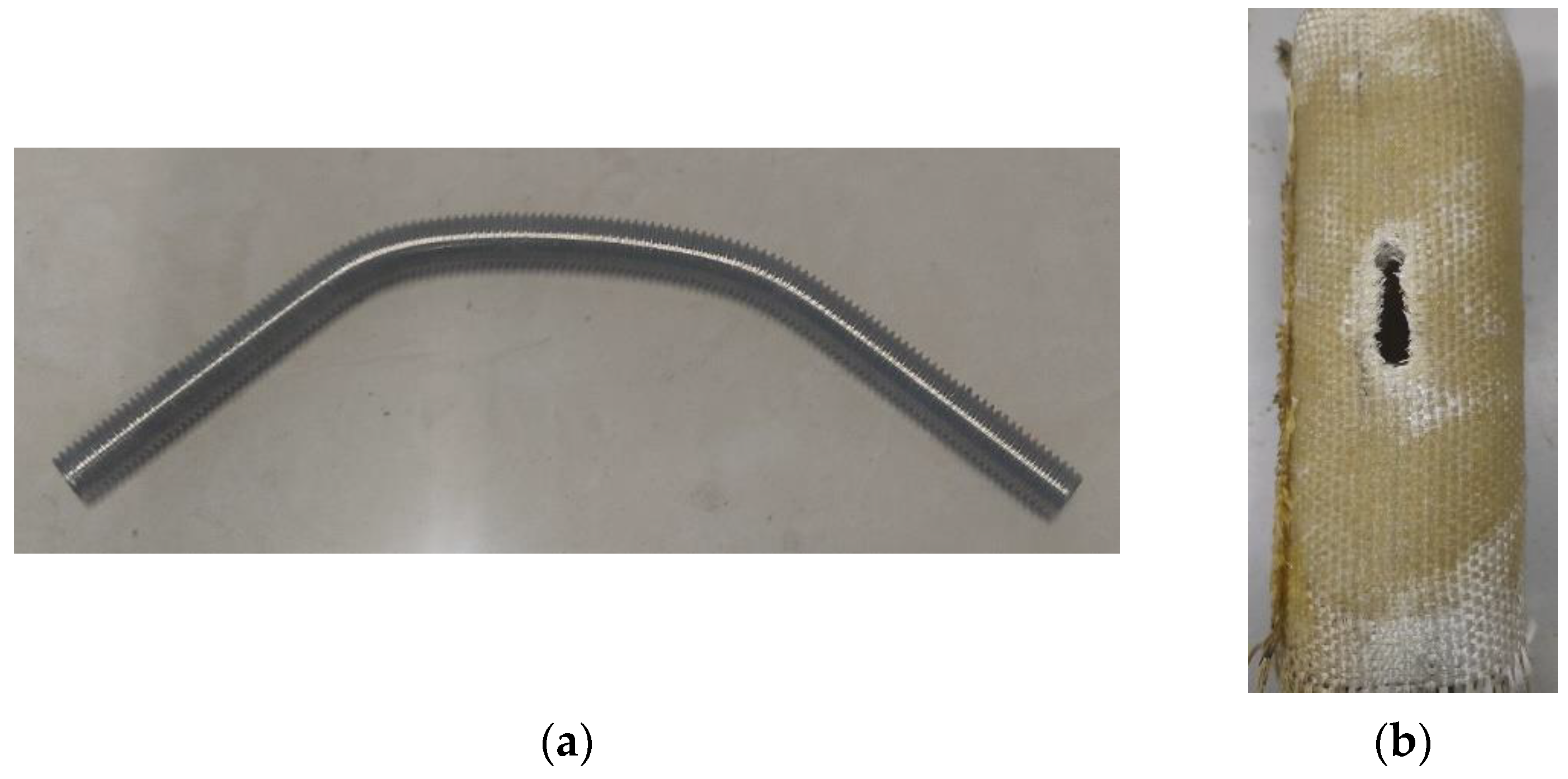
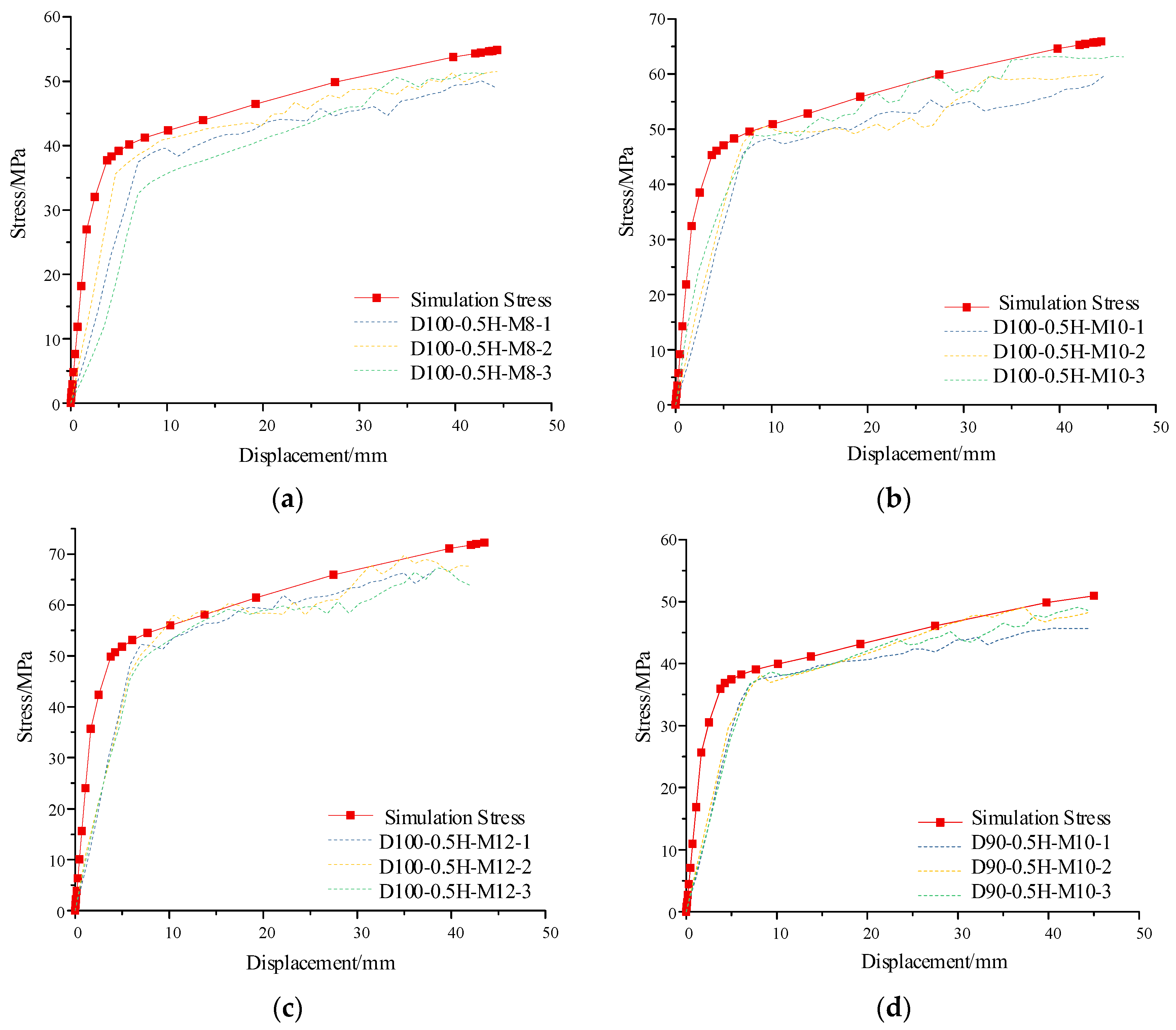

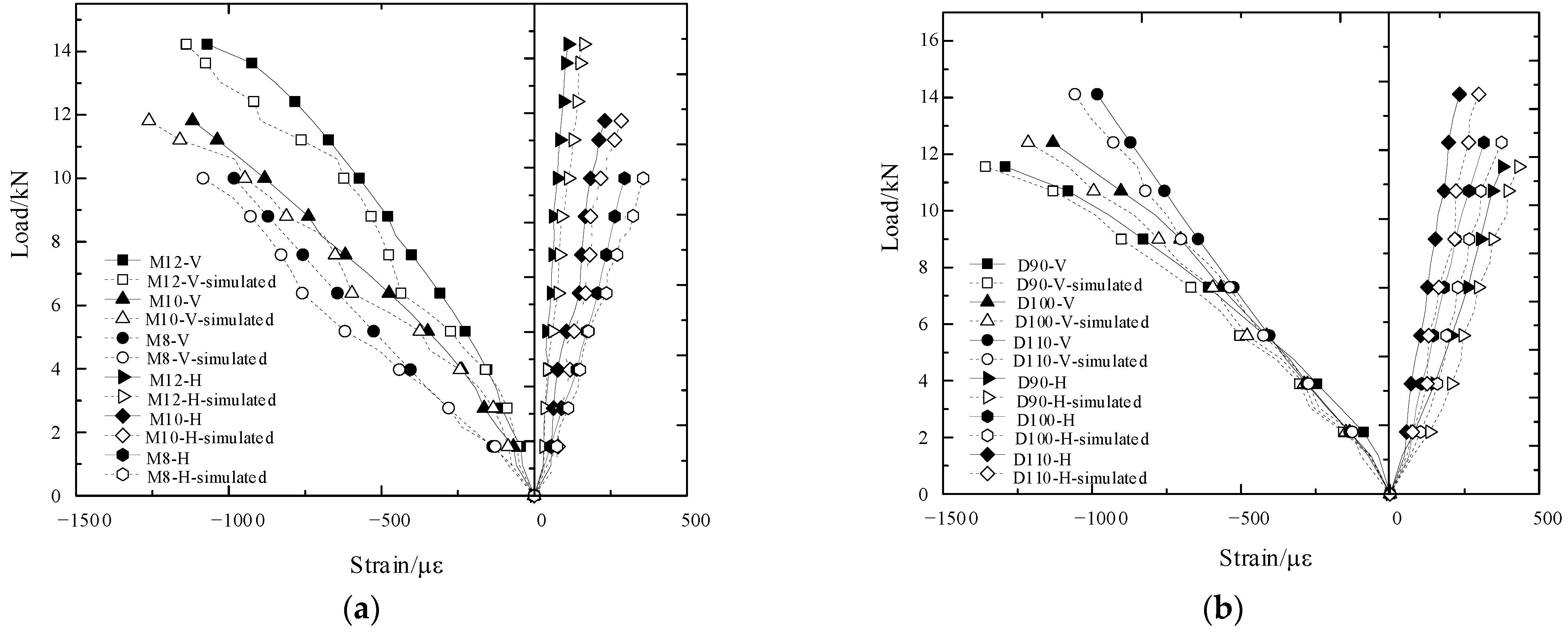


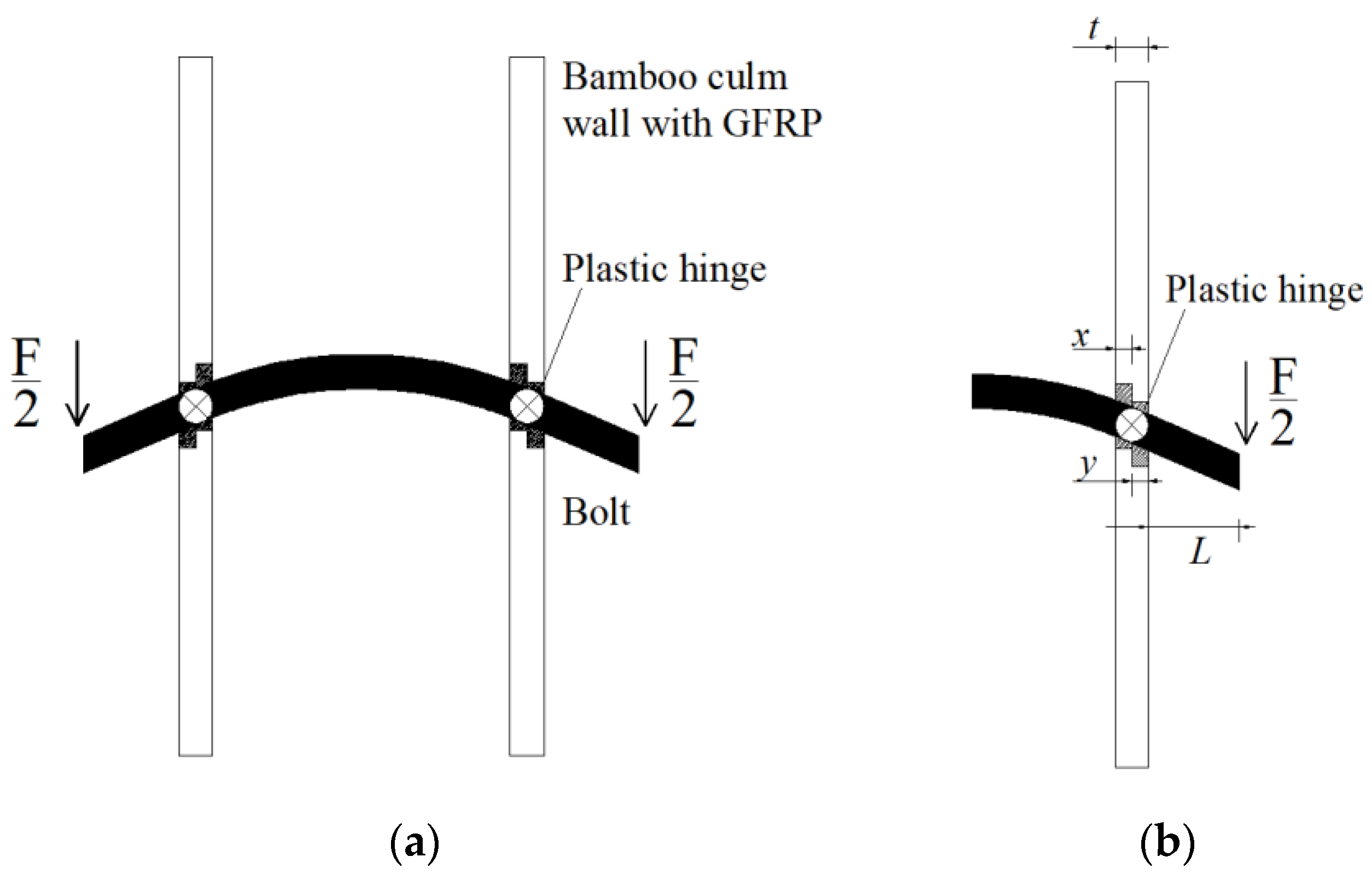
| Outer Diameter/mm | End Distance | Screw Diameter/mm | Wall Thickness/mm |
|---|---|---|---|
| 90 | H/2 | 10 | 10 |
| 100 | H/2 | 10 | 10 |
| 110 | H/2 | 10 | 10 |
| 100 | H/2 | 10 | 10 |
| 100 | H/4 | 10 | 10 |
| 100 | 3H/4 | 10 | 10 |
| 100 | H/2 | 8 | 10 |
| 100 | H/2 | 12 | 10 |
| Tensile Elastic Modulus (Et)/GPa | Tensile Strength (ft)/MPa | Tensile Elastic Modulus (G)/GPa | Shear Strength (fv)/MPa | Elongation (δ)/(%) |
|---|---|---|---|---|
| 14.1 | 173.5. | 1.1 | 22.3 | 1.8 |
| E1/GPa | E2 = E3/GPa | G12 = G13/GPa | G23/GPa | Poisson Ratio |
|---|---|---|---|---|
| 14 | 1.2 | 1.1 | 1 | 0.18 |
| Group | Simulated Value/MPa | Test Value/MPa | Error/% |
|---|---|---|---|
| D100-0.5H-M8 | 54.83 | 53.95 | 1.63 |
| D100-0.5H-M10 | 65.91 | 61.08 | 7.91 |
| D100-0.5H-M12 | 72.24 | 68.01 | 6.22 |
| D90-0.5H-M10 | 50.92 | 47.51 | 7.19 |
| D110-0.5H-M10 | 76.42 | 70.49 | 8.42 |
| D100-0.25H-M10 | 64.81 | 60.36 | 7.36 |
| D100-0.75H-M10 | 67.21 | 62.58 | 7.40 |
| Specimen Group | Simulated Value /MPa | Analytical Value /MPa | Analytical Correction Value/MPa | Test Value /MPa | Simulated Error /% | Analytical Error /% | Analytical Correction Error /% |
|---|---|---|---|---|---|---|---|
| D100-0.5H-M8 | 54.83 | 32.00 | 44.16 | 50.95 | 7.63 | −37.19 | −13.32 |
| D100-0.5H-M10 | 65.91 | 42.64 | 58.85 | 61.08 | 7.91 | −30.19 | −3.66 |
| D100-0.5H-M12 | 72.24 | 53.80 | 74.25 | 68.01 | 6.22 | −20.89 | 9.17 |
| D90-0.5H-M10 | 50.92 | 36.05 | 49.75 | 47.51 | 7.19 | −24.12 | 4.71 |
| D110-0.5H-M10 | 76.42 | 51.60 | 71.21 | 70.49 | 8.42 | −26.79 | 1.03 |
| D100-0.25H-M10 | 64.81 | 41.76 | 57.63 | 60.36 | 7.36 | −30.81 | −4.52 |
| D100-0.75H-M10 | 67.21 | 42.87 | 59.16 | 62.58 | 7.40 | −31.50 | −5.47 |
Publisher’s Note: MDPI stays neutral with regard to jurisdictional claims in published maps and institutional affiliations. |
© 2022 by the authors. Licensee MDPI, Basel, Switzerland. This article is an open access article distributed under the terms and conditions of the Creative Commons Attribution (CC BY) license (https://creativecommons.org/licenses/by/4.0/).
Share and Cite
Li, Q.; Ji, X.; Jin, Z.; Xu, J.; Yang, S.; Lv, S. Numerical Simulation of the Shear Capacity of a GFRP-Strengthened Natural Bamboo-Bolt Composite Joint. Polymers 2022, 14, 3024. https://doi.org/10.3390/polym14153024
Li Q, Ji X, Jin Z, Xu J, Yang S, Lv S. Numerical Simulation of the Shear Capacity of a GFRP-Strengthened Natural Bamboo-Bolt Composite Joint. Polymers. 2022; 14(15):3024. https://doi.org/10.3390/polym14153024
Chicago/Turabian StyleLi, Quanfeng, Xiaodong Ji, Zihao Jin, Jin Xu, Shihan Yang, and Shumin Lv. 2022. "Numerical Simulation of the Shear Capacity of a GFRP-Strengthened Natural Bamboo-Bolt Composite Joint" Polymers 14, no. 15: 3024. https://doi.org/10.3390/polym14153024
APA StyleLi, Q., Ji, X., Jin, Z., Xu, J., Yang, S., & Lv, S. (2022). Numerical Simulation of the Shear Capacity of a GFRP-Strengthened Natural Bamboo-Bolt Composite Joint. Polymers, 14(15), 3024. https://doi.org/10.3390/polym14153024





